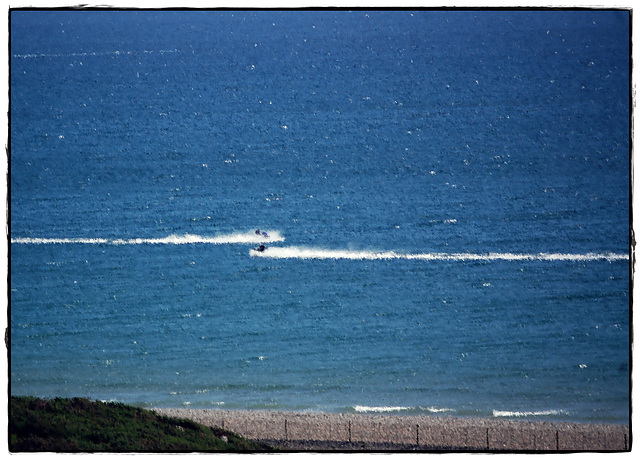Walking alone
Autumn Leaves
October leaves
Photos of 11/20/08
Krashna / Krishna
Wheel
School time
Pilgrim House
Cardinal
Woody
Another Reason Why I Don't Keep A Gun In The House
Not just a sandwich....
The Ladder
Night Migrations
Art
Snow
Hulett Street
Great Harvest
Warming up
Forsaken
Green vision
Sheds
Acquaninted with the night
Yellow
Morning after
Physicist at dinner
Transportation
Leaf
Barn
Barn
Cloudy day
The Far Road
Fall Morning
Volks
House of my childhood
Encroaching
Dusk
Spring
Keywords
Authorizations, license
-
Visible by: Everyone -
All rights reserved
-
164 visits
Oinopa ponton


It is well known that many colors we take for granted had no name for a long time, and had no names in the central texts in Western culture. Ancient Mediterranean texts, both Greek and Semitic, also had a reduced vocabulary of a small number of colors polarized around the dark and the light – Homer and his contemporaries were limited to about three or four main colors: black, white, and some indeterminate part of the rainbow, often subsumed as red, or yellow.
I contacted Guy Deutscher. He was extremely generous with his help and pointed out to me that the ancients even lacked words for something as elementary as blue. This absence of the word “blue” in ancient Greek explains the recurring reference by Homer to the “wine-dark sea” (oinopa ponton), which has been quite puzzling to readers.
Interestingly, it was the British Prime Minister William Gladstone who first make this discovery in 1850s (land was unfairly and thoughtlessly reviled for it by the usual journalists). Gladstone, quite an erudite, wrote, during his interregnum between political positions, an impressive seventeen hundred page treatise on Homer. In the last section, Gladstone announced this limitation of color vocabulary, attributing our modern sensitization to many more nuances of color to a cross-generational training of the eye. But regardless of these variations of color in the culture of the time, people were shown to be able to identify the nuances – unless physically color-blind. ~ Excerpt: Pages 35/36 (Antifragile by Niassim Taleb)
I contacted Guy Deutscher. He was extremely generous with his help and pointed out to me that the ancients even lacked words for something as elementary as blue. This absence of the word “blue” in ancient Greek explains the recurring reference by Homer to the “wine-dark sea” (oinopa ponton), which has been quite puzzling to readers.
Interestingly, it was the British Prime Minister William Gladstone who first make this discovery in 1850s (land was unfairly and thoughtlessly reviled for it by the usual journalists). Gladstone, quite an erudite, wrote, during his interregnum between political positions, an impressive seventeen hundred page treatise on Homer. In the last section, Gladstone announced this limitation of color vocabulary, attributing our modern sensitization to many more nuances of color to a cross-generational training of the eye. But regardless of these variations of color in the culture of the time, people were shown to be able to identify the nuances – unless physically color-blind. ~ Excerpt: Pages 35/36 (Antifragile by Niassim Taleb)
- Keyboard shortcuts:
Jump to top
RSS feed- Latest comments - Subscribe to the comment feeds of this photo
- ipernity © 2007-2024
- Help & Contact
|
Club news
|
About ipernity
|
History |
ipernity Club & Prices |
Guide of good conduct
Donate | Group guidelines | Privacy policy | Terms of use | Statutes | In memoria -
Facebook
Twitter

I contacted Guy Deutscher. He was extremely generous with his help and pointed out to me that the ancients even lacked words for something as elementary as blue. This absence of the word “blue” in ancient Greek explains the recurring reference by Homer to the “wine-dark sea” (oinopa ponton), which has been quite puzzling to readers.
Interestingly, it was the British Prime Minister William Gladstone who first make this discovery in 1850s (land was unfairly and thoughtlessly reviled for it by the usual journalists). Gladstone, quite an erudite, wrote, during his interregnum between political positions, an impressive seventeen hundred page treatise on Homer. In the last section, Gladstone announced this limitation of color vocabulary, attributing our modern sensitization to many more nuances of color to a cross-generational training of the eye. But regardless of these variations of color in the culture of the time, people were shown to be able to identify the nuances – unless physically color-blind. ~ Excerpt: Pages 35/36 (Antifragile by Niassim Taleb)
Sign-in to write a comment.